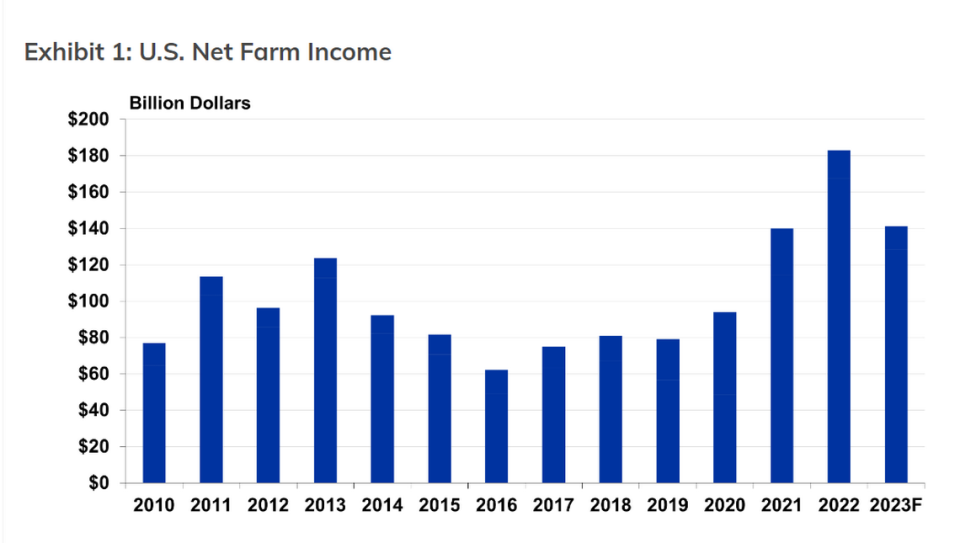Number of Kentucky farms and farmers shrinking, but sales are record breaking
The number of farms and farmers in Kentucky continued down in the latest tally but agriculture remained an important sector of the state’s economy, with the value of production at a record $8 billion in 2022.
Those were among the findings in the latest census of agriculture, released earlier this month.
The U.S. Department of Agriculture does a survey of agricultural producers every five years. The latest nationwide census covers 2022.
The report is a comprehensive collection of data on U.S. agriculture that covers a wide range of information, including crop and animal production and sales, land ownership and the characteristics of producers.
The $8 billion in agricultural production reported by Kentucky producers for 2022 was nearly 40 percent higher than the figure for 2017, the year of the last census, state Agriculture Commissioner Jonathan Shell said in a release.
Of that total in 2022, sales of poultry and livestock accounted for $4.2 billion and crops such as corn and soybeans made up $3.8 billion, Shell said.
“We know agriculture is a large part of our history, but these numbers show it is also moving our future forward,” Shell said in a release.

The state saw robust 2022 sales despite a range of challenges that included tornadoes in Western Kentucky, flooding in Eastern Kentucky, trade disruptions and high costs for supplies, economists from the University of Kentucky College of Agriculture, Food and Environment said at a presentation to the Kentucky Farm Bureau.
“Despite all those challenges, the Kentucky agricultural economy remained strong overall,” Will Snell, an agricultural economist at UK, said at that meeting.
U.S. Department of Agriculture census on Kentucky farms
Here are selected findings from the 2022 census:
How many farms, farmers are in Kentucky?
Kentucky had 69,425 farms in 2022, down from 75,966 in 2017 and 86,541 in the 2002 census.
Snell said the 9% drop in farms in Kentucky was larger than the national decline of 7% from 2017.
The amount of land used for agriculture also dropped from 12.9 million acres in 2017 to 12.4 million in 2022. In the 2002 census, the state had 13.8 million acres of farm land.
Those declines mirror a national trend.
The country lost 142,000 farms between 217 and 2022, leaving the number at just over 1.9 million, U.S. Agriculture Secretary Tom Vilsack said in a presentation to release the 2022 census.
Vilsack said the decline points up the need to develop additional ways for farmers to make money — such as converting manure into fuel — to try to preserve more small and mid-size farms and the rural economy they support.
“This survey . . . is a wake-up call,” Vilsack said.

Kentucky retained its spot in the top 10 states nationally in the number of farms, though it was far behind Texas, with 231,000 farms and ranches and 125 million acres in farms.
The number of agricultural producers in Kentucky dropped from 122,995 in 2017 to 119,132 in 2022, and their average age also crept up, from 56.2 years in 2017 to 57.1 years in 2022.
Most people who farm in Kentucky also work another job, often out of necessity to prop up farm income.
Of the 119,132 producers in 2022, only 43,697 listed farming as their primary occupation.
In an April 2023 analysis of federal farm legislation, Snell said Vilsack has pointed out that while U.S. agriculture set a record-high net farm income in 2022, most farms still lost money and depended on off-farm income
The average size of a farm in Kentucky crept up to 179 acres from 171 acres.

Many farming operations in Kentucky are relatively small, with more than 27,000 reporting the market value of products sold at less than $2,500.
The census showed there were 1,753 farms in Kentucky — 2.5 percent of all farms — that had more than $1 million in gross sales in 2022, Snell said.
The top five Kentucky counties in terms of the number of farms in 2022, according to Shell’s office, were Barren, 1,621; Pulaski 1,600; Warren, 1,530; Shelby, 1,350; and Grayson, 1,283.
Fayette County had 682 farms; 124,247 acres in agricultural land; and $333 million in the market value of agricultural products sold.
What is grown the most on Kentucky farms?
Net cash farm income in 2022 was $2.4 billion. That was an increase of 56 percent increase over 2017, according to the release from Shell.
Poultry and eggs were the top agricultural commodity in Kentucky in 2022, at $1.79 billion in the market value of sales.
The other commodities in order were corn, $1.46 billion; soybeans, $1.38 billion; cattle, $1.08 billion; horses, $736 million; wheat, $262 million; milk, $233 million; tobacco, $225 million; and hogs and pigs, $207 million.
Most of those sales were up considerably over 2017 — corn was up 76 percent, for instance — except tobacco, which was down 36 percent.

How much tobacco is grown in Kentucky?
Tobacco was a mainstay in Kentucky agriculture for decades but the industry waned after the federal government ended a Depression-era program that limited how much farmers could grow and provided a guaranteed payment per pound.
Only 984 farms produced tobacco in Kentucky in 2022, down from 29,237 in 2002 and nearly 60,000 in the early 1990s.
Kentucky’s tobacco industry has “arguably experienced the largest structural change of any sector and state in U.S. agriculture over the past two decades.”
The census is a snapshot of agriculture in Kentucky and the nation, which can change significantly from year to year because of everything from bad weather to global trade changes.
UK economists projected that the final tally of the state’s farm cash receipts for 2023 would fall back modestly from the record high in 2022.


